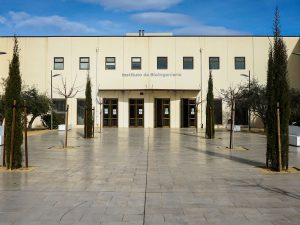
- Viernes 21 de febrero de 2025, a las 11:30h
- Salón de actos del IB, Edif. Vinalopó.
- Campus de Elche de la Universidad Miguel Hernández, España
- https://www.cbgp.upm.es/index.php/en/?option=com_content&view=article&id=1139
Transcriptional termination and chromatin silencing, a link found through flowering time
Summary of the talk: Transcription has been classically explained as a three-step reaction: RNAPII initiation, elongation, and termination regulated chiefly through transcription factor association. While initiation and elongation have received most of the attention, termination is emerging as a key regulatory step, controlling the fate of the transcript and influencing chromatin silencing. Through the study of the Arabidopsis FLOWERING LOCUS C (FLC) mechanisms underlying RNA 3’ processing-mediated Polycomb Repressive Complex 2 (PRC2) silencing, a number of factors playing generic roles in RNAPII transcription, pre-mRNA processing, and chromatin modifications were found. Generically, they promoted proximal termination of both FLC and the antisense long non-coding RNA COOLAIR. However, how proximal termination delivers a changed histone environment that enables the PRC2 switch was still enigmatic. By means of Immunoprecipitation followed by Mass Spectrometry, co-IP, 3´mRNA-seq, plaNET-seq, chRNA-qPCR, and ChIP-qPCR experiments we showed that APRF1, homologous to CPF phosphatase module component Swd2/WDR82, forms a CPF-like phosphatase module with LD (Ref2/PNUTS) and TOPP4 (Glc7/PP1) which promotes transcriptional termination. APRF1-dependent RNA processing activities function in the same co-transcriptional pathway as FLD, thus providing the framework to understand how the RNA processing and the chromatin remodeling function together to modify FLC chromatin environment and affect its transcriptional output. This chromatin environment reinforces proximal termination choice so providing the molecular feedback necessary to stably maintain a low transcription state.
Eduardo Mateo Bonmatí holds a degree in Biochemistry from the Universidad Miguel Hernández de Elche (UMH; 2012), where he also obtained a Master in Bioengineering (2013). In 2018, after obtaining his PhD, also at the UMH, under the supervision of Professor José Luis Micol, he joined the laboratory of Professor Karin Ljung, where he spent a first postdoctoral period until 2020 at the Umeå Plant Science Centre in Sweden. Between 2020 and 2022, he spent a second postdoctoral period at the John Innes Centre, UK, under the direction of Professor Caroline Dean, a world-class scientist in plant molecular biology. Since 2023, Eduardo has been a Ramón y Cajal researcher at the Centro de Biotecnología y Genómica de Plantas (CBGP), a joint centre of the Universidad Politécnica de Madrid and INIA/CSIC. Since 2024, Eduardo has led his first research project and a nascent research group at the CBGP

